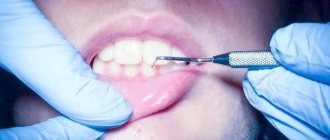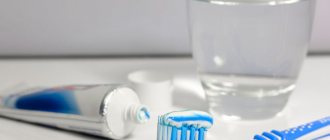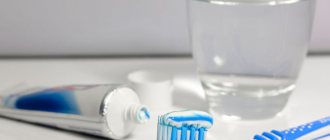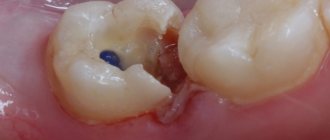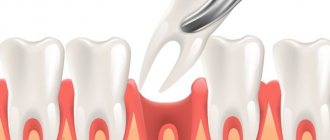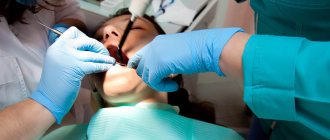- What is this
- Kinds
- Causes
- Consequences
- Treatment
- Prevention
Plaque accumulates on the teeth due to insufficient oral hygiene, which hardens over time. This is how tartar forms, which causes a lot of trouble. It not only spoils the appearance of teeth, creates bad breath, but also leads to serious diseases. We will tell you clearly about why it is dangerous, what it looks like, how to deal with it and what is the prevention of its occurrence.
What it is
Tartar is a hardened plaque that forms in adults and very rarely in children, and even then in the presence of a history of serious diseases such as heart disease or diabetes. Usually, if you spend enough time on hygienic procedures to remove plaque, stones will not form on your teeth. If plaque is not allowed to harden, stones cannot form. Therefore, thorough brushing of teeth is the best means of prevention.
Tartar can occur on one single tooth or on several teeth. The lower front teeth, as well as the upper and lower molars, are most susceptible to tartar formation.
Signs:
- Tartar causes bad breath;
- gums begin to itch and bleed;
- Dark stains appear on the visible surfaces of the teeth that cannot be removed with a brush.
Tartar can form not only on enamel, but also on crowns or dentures. Therefore, those who do not have their own teeth in their mouth, but only dentures, should not relax - stone can form on them, just like on the surface of the enamel. It, of course, will not lead to caries on the crown, but it can provoke inflammation of the gums, and also significantly spoil the appearance of the dentures.
Plaque from tea and cigarettes can provoke the formation of tartar. The constant presence of such plaque on hard-to-reach enamel surfaces inevitably leads over time to the formation of dense deposits, including stones.
Why does plaque form?
Dental plaque forms on the teeth of all people. They are the cause of many dental pathologies. Normally, the mouth contains oral fluid (saliva), microorganisms, and food debris. Immediately after brushing, a pellicle appears on the surface of the tooth - a transparent film consisting of salivary proteins. It plays a protective role, but also promotes the attachment of microbes to the surface of the tooth. Already 2-3 hours after cleaning, microorganisms are deposited on the pellicle, and after eating food particles become deposited. Throughout the day, plaque forms, which is localized in the cervical area of the tooth.
With regular care, plaque is easily removed, but with poor hygiene, its remains remain in the most inaccessible places: under the gums, between the teeth. Over time, salts are deposited in the soft plaque, which becomes hard and can only be removed by a dentist using special instruments.
There are factors that contribute to the formation of plaque:
- Poor level of hygiene;
- Violation of saliva properties (quantity, viscosity, pH);
- Incorrectly selected brush and paste;
- The predominance of soft food in the diet;
- Metabolic diseases, especially mineral metabolism;
- Diseases of the salivary glands;
- Excessive consumption of coffee, tea, pigmented foods;
- Some diseases of the body (gastrointestinal diseases, diabetes mellitus);
- Bad smoking habit;
- Decreased immunity.
Kinds
There are two types of tartar, depending on its location - subgingival and supragingival.
Subgingival tartar can only be detected by a dentist using a special probe, since it is hidden from view by the edge of the gum. It is located in the periodontal pocket and fits tightly to the root. The color of this stone is usually dark brown or greenish-black, it is extremely hard and consists mainly of calcium phosphate, magnesium phosphate and calcium carbonate. If subgingival stone is not removed in a timely manner, it can provoke an inflammatory process in the periodontium and cause periodontitis.
Supragingival tartar can be diagnosed independently; it stands out on the surface of the enamel with its yellowish or brownish color and is easily removed using a dental excavator. It is usually located above the crest of the gingival margin, so it is easy to recognize. In terms of density, supragingival stone is much softer than subgingival stone, since it is a salivary type formation and consists mainly of epithelial cells, bacteria, mucus and food debris. If it is not removed in a timely manner, over time the hardened plaque turns into caries.
Causes of plaque formation
- Irregular or improper care, lack of timely removal of food debris;
- Predominance of carbohydrates in food;
- Low chewing activity;
- Pathologies of the digestive system;
- Individual characteristics of saliva composition.
Signs of deposits:
- There is no shine on the enamel;
- The texture of the enamel changes and becomes rough;
- Darkening of the enamel is noticeable in certain areas.
At first the coating is white, but over time it changes color to yellow, then acquires a brownish and even greenish tint. These deposits are noticeable from the outside and do not look aesthetically pleasing.
If you do not take cleansing measures:
- An unpleasant odor appears;
- The area where plaque accumulates is expanding;
- The enamel surface becomes rough.
In people who frequently drink coffee and tea, as well as in smokers, the plaque becomes dark and difficult to remove.
Causes
If you have stones, the reason for their occurrence may be the following:
- lack of systematic oral hygiene;
- use of low-quality accessories for brushing teeth;
- the presence of a large amount of dental plaque;
- violation of salt metabolism;
- increased viscosity of saliva, as a result of which it loses its cleansing properties and does not wash away plaque;
- insufficient consumption of solid foods, which promote self-cleaning;
- unilateral chewing of food (only on the left or only on the right side of the jaw) as a result of the presence of diseased or missing teeth in the patient’s mouth;
- increased roughness of the enamel surface as a result of filling or orthodontic treatment;
- smoking.
Read more about the possibilities of ultrasonic cleaning
Let's continue the conversation about ultrasonic teeth cleaning - the most effective modern method of removing dental plaque, almost completely safe and capable of cleaning teeth from:
- plaque, including pigmentation;
- stone at the base of the tooth, above and below the gum.
The procedure is performed using an ultrasonic scaler, through which water is supplied through a vibrating metal nozzle: high-frequency vibration destroys deposits on both sides of the tooth, and the water flow washes out these particles. There simply cannot be any hard-to-reach places for an ultrasound scaler.
The effect is complemented by an antibacterial effect. The procedure is indicated for use with a regularity of once a year.
A competent dentist will definitely prescribe teeth cleaning before treatment; before dental operations, the procedure is absolutely necessary.
This treatment will reliably protect against infection by removing bacteria and germs from the oral cavity. Ultrasound cleaning will also help when choosing the color of fillings and implants.
The importance of the procedure during implantation is determined by the following points:
- deep cleaning of periodontal pockets, including hard-to-reach ones;
- disinfection of dental sinuses and canals;
- teeth whitening on both sides;
- prevention of caries and gingivitis.
Consequences
Many people do not consider the formation of tartar to be a problem and are in no hurry to see a dentist. If plaque has formed on the inner surface of the teeth, it is invisible during communication, and the person mistakenly believes that the problem does not exist. In fact, the appearance of stone is quite dangerous for the health of teeth and gums. Let's start with the fact that its location at the very edge of the gum can cause gum bleeding over time and contribute to the formation of a periodontal pocket in which food debris will accumulate, causing inflammatory processes in the gum.
If the stone is not removed in time, the consequences can be dire, including loss of teeth. After all, dental plaque is an excellent environment for the proliferation of pathogenic bacteria, in particular those that cause caries.
We must remember that the process of formation of tartar is long, so a systematic visit to the dentist will help get rid of the cause in a timely manner, avoiding complications. It is useful to carry out professional hygiene procedures at least 2-3 times a year, including the removal of dental plaque. This will help avoid such unpleasant consequences as bad breath, caries and inflammatory gum diseases.
Is it necessary and possible to remove tartar?
Looking ahead, we will immediately inform you: tartar is harmful and should be removed. And now more about its harm, reasons for its appearance and methods of removal.
Everyone is well aware of the general recommendations dentists give to their patients: thorough oral hygiene, including regular brushing of teeth with high-quality pastes, the use of dental floss and rinsing with disinfectants. But some people do not strictly follow these doctor’s orders, or even forget about them altogether.
Many patients do not pay special attention to personal oral hygiene simply because they do not know whether the tartar that forms as a result of such negligence is harmful. And he, of course, is harmful! Because of it, dark plaque appears, bad breath and bleeding gums, and the result of all this can be the development of chronic diseases and tooth loss.
What harm does tartar cause?
The main harm of tartar is the creation of a favorable environment for pathogenic bacteria, which cause a number of inflammatory diseases of the oral cavity, including gingivitis, stomatitis, caries and periodontitis. In addition, hardened deposits, gradually increasing, descend deep into the tooth socket, forming voids or periodontal pockets. As a result, the tooth loses stability, begins to wobble and may simply fall out.
Reasons for the formation of tartar
The human oral cavity is home to many bacteria and microorganisms that form a thin film of plaque, which over time turns into tartar. Hard bacterial deposits also consist of food particles deposited in subgingival and supragingival areas. In order to decide whether to remove tartar and how urgently it needs to be done, you should consult a dentist for advice.
Factors that provoke the appearance of tartar
Experts identify a number of factors that can trigger and accelerate the appearance of tartar:
- Irregular or improper brushing of teeth
- brushing teeth with low-quality toothpastes
- smoking
- excessive consumption of coffee and tea
- using exclusively soft foods in the diet
- habit of chewing food on only one side of the jaw (for example, due to tooth decay or missing teeth)
- poorly performed filling procedure
- metabolic disease
Signs of the appearance of tartar
You should consult a dentist at the first signs of the appearance of tartar. These include:
- bad breath
- bleeding and gum inflammation
- development of periodontitis and caries
- increased sensitivity of tooth enamel
When is it necessary to remove tartar?
The indication for tartar removal is the need for dental treatment, such as prosthetics and dental fillings. In addition, during professional cleaning, the canals and periodontal pockets are washed, which prevents the development of infections after tooth extraction. This procedure is also prescribed by the dentist before treating gum inflammation. Patients who care about their oral health have no doubt about whether it is necessary to remove tartar. The answer is clear: it is necessary! But you need to do it right
How to remove tartar
Dentists quite often hear the question: “Is it possible to remove tartar at home?” But, unfortunately, using toothbrushes, threads or special brushes, it is possible to remove only soft plaque. Home remedies are powerless in the fight against hard deposits. It is better not to experiment with folk remedies - some of them can cause significant harm to dental health. To get rid of tartar, dental clinics offer the following methods of hygienic teeth cleaning: ultrasonic, laser, chemical, and, less often, mechanical. Professional removal of tartar will allow the patient to forget about the problem for at least the next six months, after which the procedure will need to be repeated.
Expert opinion
Professional teeth cleaning is a very good decision, but it cannot replace regular oral care.
To prevent the formation of tartar during home procedures, you should use toothpastes containing antiseptics, soft abrasives, and chemical compounds based on pyrophosphates. The type of professional teeth cleaning that is best suited specifically for you and takes into account all your individual characteristics (the condition of the gums and teeth, the sensitivity of tooth enamel, the degree of tartar deposits) should be advised by a qualified attending physician.
You need to understand that such cleaning is not the same as bleaching them. A slight whitening effect may indeed appear after this procedure, but it will still be insignificant. After all, the main task of the dentist in this case is to rid the patient of tartar and maintain the health of his teeth.
Other procedures, such as Luma cool or Air flow whitening, will help make your smile aesthetically attractive. True, none of them can do without preliminary professional hygienic cleaning.
Treatment
Treatment for stones consists of removing them; there are simply no other methods of treatment. Sometimes it happens that tartar is removed from the surface of the teeth by itself under the influence of solid food, but you should not hope for this. It is better to consult a specialist in a timely manner, a hygienist who will quickly and painlessly remove dental deposits from the surface of the enamel.
If earlier tartar removal was carried out mechanically, that is, it was simply scraped off the surface of the enamel, today there are more modern and painless methods for removing deposits. Among them, the most common is the ultrasonic method of teeth cleaning.
Using the ultrasonic method, the dentist will quickly and effectively remove all dental plaque without injuring either the gums or the enamel surface. The procedure for removing tartar is completed by polishing and grinding the enamel, during which the teeth become shiny and their surface is smooth.
Ultrasonic teeth cleaning is the best modern solution
The ultrasonic method of removing tartar combines high productivity and special advantages, such as:
- No aggressive or harmful chemical effects on enamel;
- Minimal trauma, can be used even with fragile tooth enamel;
- The ability to effectively act on deposits of any nature, removing plaque even in hard-to-reach places;
- The presence of an antiseptic effect (elimination of harmful microorganisms);
- Efficiency and painlessness of the procedure;
- Affordable price.
Prevention
The main task of the patient is to reconsider his attitude towards oral hygiene, since it is due to insufficient or improper brushing of teeth that stones form on their surface. It is very important to brush your teeth twice a day, morning and evening. But it is equally important to do it correctly, thoroughly cleaning all surfaces of the teeth, including hard-to-reach ones, from plaque. This is exactly what a hygienist can teach you, as well as select the toothpaste you need and recommend a brush of the required hardness.
Dentists recommend not saving on high-quality toothpastes and brushes, since the effectiveness of hygiene procedures depends on them. Using an electric brush with various attachments allows you to more thoroughly clean the surface of your teeth from plaque. Dentists also recommend professional teeth cleaning at least twice a year, during which the doctor will remove all dental deposits that can turn into stone over time. It is also necessary to consume solid food, which helps to cleanse teeth of plaque.
Methods for removing dental plaque
Professional removal of dental plaque is carried out using several techniques. The choice of method is carried out individually; sometimes a specialist combines cleaning methods to achieve maximum results.
- Chemical cleaning. The technology is based on the application of special chemical-based preparations to the teeth, which soften deposits and facilitate easy separation from the dental surface. In modern dentistry, it is rarely performed due to the risk of complications.
- Manual cleaning. Teeth cleaning with the help of instruments is practically not carried out. During the procedure, soft gum tissue can be damaged, and it is very difficult to remove tartar from hard-to-reach places.
- Ultrasonic plaque removal. Cleaning with an ultrasonic scaler is the most popular and effective cleaning method. The procedure is carried out with a handpiece, which, using ultrasonic vibrations, easily destroys and removes hard dental deposits.
- Laser plaque removal. Laser beam cleaning is the newest, safest method of cleansing. The procedure is easy, quick and effective.
- Air Flow teeth cleaning. The procedure using a sandblasting machine is one of the best and most common methods of professional hygiene. The method is based on supplying a cleaning mixture (water, air, abrasive particles) under pressure onto the tooth surface using a tip. As a result of the manipulation, not only the ideal cleansing of the dentition occurs, but also the enamel is lightened to natural shades.
- Gum curettage. The curettage procedure involves cleaning subgingival dental plaque using special instruments. It is carried out for diseases of periodontal tissues, the formation of gingival and periodontal pockets.
Cleaning at home
At home, teeth should be brushed twice a day: in the morning after breakfast and in the evening before bed. Basic hygiene products include: toothpaste, brush, floss. Additional products that are also recommended to be used: irrigator, mouthwash, interdental brushes. There are also folk remedies for cleansing, these may be unsafe or ineffective and should only be used after consulting a doctor.
- Soda. Can be used for brushing teeth no more than once a week, as it contains large abrasive particles. With constant use, it can scratch the enamel and cause increased sensitivity.
- Hydrogen peroxide. It is advisable to use an antiseptic drug for inflammatory diseases of the oral cavity (gingivitis, stomatitis, periodontitis). It will not be effective for cleaning teeth.
- Strawberry. The berry contains some acids, but they are not able to clean plaque from teeth. Strawberries will not cause harm, but you should not expect any effect.
- Lemon. Use lemon to brush your teeth carefully, as the acid content can negatively affect dental health. Compared to a brush and paste, lemon is ineffective for cleaning.
- Activated carbon. The product can be used once a week. Its cleansing effect is due to its abrasive structure. Frequent use can cause cracks, scratches and surface damage to the enamel structure.
Cleaning teeth with a sandblaster (Air-Flow method)
Thanks to this method, you can gently and without consequences remove soft deposits (but not a lot of tartar!), and also lighten the enamel by 0.5 tones (relevant for smokers and coffee lovers). The meaning of the device is very simple - an abrasive (usually based on soda) is poured into a special flask. Water enters there (into the flask), and this entire mixture, under high pressure, cleans off all the deposits.
Advantages:
- The technology allows you to clean the most inaccessible corners of the oral cavity (for me personally, cleaning the interdental spaces with this method brings great joy. A sandblasting machine cleans in a way that no other machine can do).
- The ability to soften any deposits and particles of tartar, as well as remove plaque and age spots.
- Speed of implementation - in standard cases it will take up to 30 minutes.
- Comfort and painlessness. There are times when this method causes discomfort. But you and I can easily cope with it, thanks to additional recommendations.
- Safety - the device does not damage enamel and gums, and the natural components of polishing powders do not cause harm.
- Additional polishing of tooth enamel - abrasive particles eliminate roughness and smooth the surface of the teeth.
- Gum massage is an additional effect of the procedure, which improves blood supply and metabolic processes in soft tissues.
- Ability to clean braces, implants and other orthopedic structures.
Flaws:
- The main disadvantage of sandblasting is that it does not remove massive mineralized formations (tartar). The device only removes pigmented plaque and soft bacterial deposits well, and does a much worse job even with small tartar.
